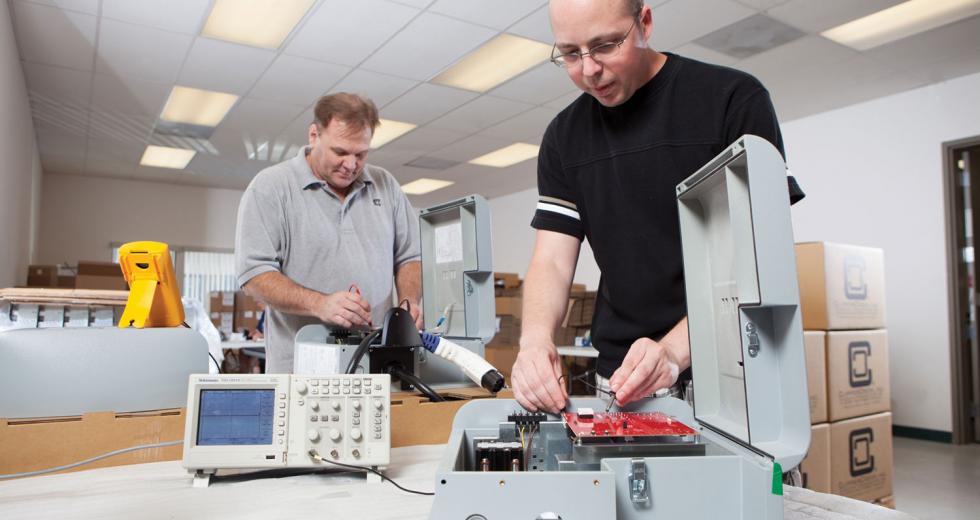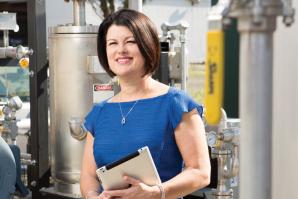Beutler Air Conditioning and Plumbing may be a poster-business for the rise and fall — and re-birth — of Sacramento’s economy. Rick Wylie, president of Beutler, says the 65-year-old Sacramento company was probably saved by its diversification, partially into green energy models.
The company, which had built its business around commercial heating, air conditioning and sheet metal work, had 2,100 employees in six offices throughout Northern California. After a seven-year slide, the company had only 290 employees by 2011. Revenues had bottomed out to $37 million last year.
But in the past 10 years, the company has expanded into home security and theater systems, central vacuums, electrical, plumbing, solar, thermal and fire sprinklers. Finally, it branched into advanced comfort and energy systems, including home energy makeovers.
Beutler recently started manufacturing an efficient water-cooled air conditioner, AquaChill. It’s partnering with Sacramento Municipal Utility District and SoCal Edison, a Southern California power company, for rebates on installation of units, and has entered the markets of Pennsylvania and Arizona.
The company is now expecting revenues of $44 million, a 19-percent jump, and added 160 employees in the past five months. Wylie predicts another jump to $60 million next year, which would be 35 percent growth.
In the Capital Region, promises of greenbacks from green business are starting to sound like a broken record, making some cautious about prophesying quick payoffs. But a growing number of businesspeople, entrepreneurs and investors are putting stock in renewable energy, energy technology and environmental technology.
“Green power — generating it, distributing it and monitoring it — is a booming industry,” says Jason France, co-founder and CEO of Clipper Creek Inc., a Rocklin company that builds and sells charging stations for electric vehicles.
“It’s attracting real investment, it’s positive for our environment and positive for our economy,” he says.
The state’s anti-global warming initiatives have helped make California a magnet for green businesses. The state’s clean tech companies attracted a record $3.5 billion in venture capital investments in 2011, up slightly from the previous high of $3.1 billion in 2008. California represents 57 percent of all clean tech venture capital funding in the country and 40 percent of the worldwide total, according to the annual California Green Innovation Index released by Next 10, a public policy group.
The state’s green businesses didn’t survive the downturn without scars, however. California lost 3 percent of its green jobs, and the entire industry suffered from Chinese competition and the highly publicized fall of solar firm Solyndra.
China is the world’s largest producer of renewable energy technology. In the last few years, China has grabbed about half of the U.S. market for solar panels. U.S. imports of Chinese solar cells were valued at about $3.1 billion last year.
In May, however, the U.S. Commerce Department announced it would impose tariffs on some key Chinese manufacturers that were selling solar panels at below-market value, a practice that had been blamed for hurting American companies.
On the domestic front, the 2011 collapse of Solyndra, a Fremont solar cell maker, gave a substantial blow to federal subsidies for the renewable energy business. After the U.S. government loaned the company $527 million, the company went bankrupt and laid off 1,100 employees. Company officials said the manufacturer was defenseless against Chinese competition.
But the state hit a major solar milestone in 2011 with the installation of enough solar panels to generate more than 1 gigawatt of electricity — an amount roughly equal to the energy use of 750,000 homes at any given time — something no other state and only five other countries can boast.
The Capital Region is uniquely benefitting from this development due to its proximity to the California Air Resources Board, four-year universities focused on related industries, and access to land and workers that are cheaper but still close to the Bay Area.
Gary Simon, co-chair of the Sacramento Area Regional Technology Alliance’s CleanStart initiative, which aims to accelerate clean tech ventures in the greater Sacramento area, believes Sacramento will soon be among the top 10 leaders in green tech business in the nation, thanks in part to contracts from the California Energy Commission.
Simon says local clean energy companies include renewable energy generation, including solar, wind, biomass, fuel cells and geothermal sources. Just as important is the area’s burgeoning market for energy efficiency products and monitoring devices, and greener storage and distribution of power.
Spurring the trend are laws, policies and building codes aimed at lowering emissions, reining in energy use and cleaning up air, water and soil. Some of the mandates are spreading to other states and even going global, opening even more opportunities for Sacramento-area based businesses.
Sacramento is fertile ground for startup companies and longtime businesses weathering decades of green energy development or reinventing themselves to take advantage of the budding green market.
According to SARTA, about 100 clean tech companies are currently operating in the greater Sacramento region, up from 30 clean tech companies in 2005, bringing in $1.5 billion in revenues and employing up to 22,000 people in manufacturing and research and development.
When the number of jobs at the California Energy Commission and utilities are added, the regional clean tech employment hovers around 37,000 people.
“That’s just the base of the pyramid,” Simon says. “With that amount of revenue and jobs, there’s a spillover effect. The impact on the region is three or four times that revenue, because of the money these businesses and employees are spending in the area.”
Over the next decade, Simon foresees the clean tech sector growing to 100,000 jobs and $10 billion in revenue.
One of the region’s sunniest windows of opportunity is in solar energy. Despite the fall of Solyndra, California solar companies brought in $1.2 billion in venture capital last year — 62 percent of the worldwide total. Meanwhile, solar employment in the state grew 166 percent between 1995 and 2010, or by about 33,000 jobs.
Simon says the Capital Region is attractive for solar projects because of subsidies offered by Sacramento Municipal Utility District and Pacific Gas & Electric.
Two dozen solar companies call the Sacramento region home, he says, many of them assembling products quickly for installation all over the state and nation, and some are outposts of larger international companies.
For example, Sunoptics traces the arc of California’s green tech path from its roots in the 1970s during the first oil embargo and energy crisis, says vice president Grant Grable. The company, which makes prismatic skylights, started 34 years ago in Sacramento.
The company specializes in “daylighting,” or products and design that maximize natural lighting in commercial, government and school buildings.
Grable says Sacramento is an ideal location for Sunoptics, because Northern California houses some of the lighting industry’s leaders due to the internationally acclaimed Lighting Technology Center at UC Davis.
“Energy is expensive, so renewable energy has been a strong focus for many years. The most cost-effective watt you will ever create is the one you don’t use,” says Grable, adding that lighting can account for up to 50 percent of a building’s electrical tab.
Sunoptics has grown its business more than 40 percent annually since 2007, doubling its total business since the recession started, Grable says. Corporate clients now include Walmart. It now sells to 27 countries, and will send its first large-container shipment to China later this year.
France agrees that green tech is being nurtured in the greater Sacramento area. Clipper Creek has a 9,000-square-foot office in Auburn, and uses local vendors to save money on fabricated metal and cardboard packaging. Since going into production in 2008, the company has seen growth in double digits every year, France says.
A recent round of venture capital funding has allowed Clipper Creek to serve the Tesla Roadster and the BMW Mini electric vehicles.
“That allowed us to reinvigorate and go into production to supply the whole market,” he says.
The principals of Clipper Creek happen to live in Grass Valley and Auburn, but being close to state lawmakers and offices, including the California Air Resources Board is a plus, he says.
“CARB had a pivotal role in the development of the electric vehicle,” France says. “We like being conveniently close to the state capital.”
Michael Kuhlmann, chief executive officer of RCS Technology, says his 20-year-old business took a hit in the recession, and has had to reinvent itself. But the CSU Sacramento graduate and former McClellan technician found a niche in electronic energy controls that he says is taking off now.
The company designs and makes controls for thermostats, pools, hot water heaters and even appliances, and is partnering with SMUD and the city of Sacramento on pilot programs to use Smart Grid metered data to allow customers to scale back on energy use during peak usage hours.
RCS’s controls are sold at Home Depot and Lowe’s.
“Sacramento is on the edge of a rising tide, with some of it flowing from the Bay Area,” Kuhlmann says. “The infrastructure has improved greatly to support tech development. SARTA helps with networking and connecting to resources, we’re receiving supportive banking through Five Star Bank, which has aggressively focused on tech companies, and we’re seeing an increase in local venture capital or angels.”
Kuhlmann understands if people are still skeptical, but he sees stability in the new wave of clean tech business.
“We’ve seen these cycles before, but this is not like the tech bubbles of the past,” he says. “We’re not seeing the Apple or HPs or other big guys building plants here, but there are more stable-growth companies, software and new businesses coming from the outside.”
Wylie says the state’s Assembly Bill 32, or the Global Warming Solutions Act of 2006, which requires the state to lower its greenhouse gas emissions to 1990 levels by 2020, could be a green tech engine in the next few years.
“This will create a whole new arena, and it’s going to drive business,” he says.
Recommended For You

Clean-Tech’s New Frontier
The green rush is over. Now what?
For much of the past decade, venture capitalists showered dollars upon clean-technology startups with promising-sounding ideas in areas like solar, electric cars and biofuels.
That era appears to have ended.




